(完整word)六年级冀教版英语下册第7课导学案)
冀教版小学英语六年级下册教学设计Lesson 7 On the School Bus
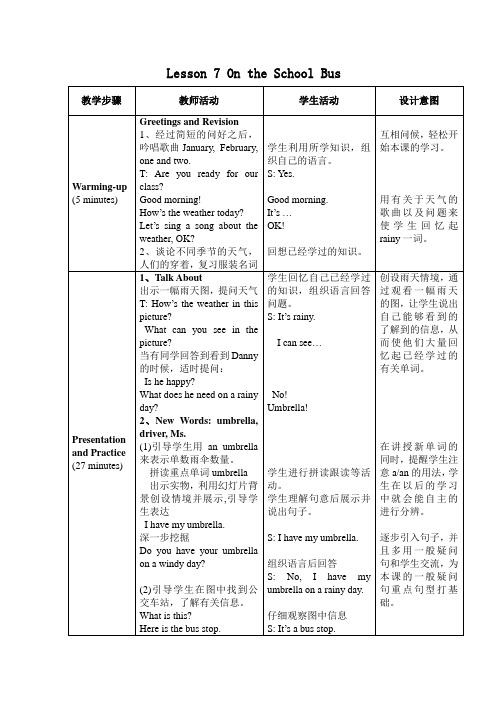
Is he happy?
What does he need on a rainy day?
2、New Words: umbrella, driver, Ms.
(1)引导学生用an umbrella来表示单数雨伞数量。
拼读重点单词umbrella
出示实物,利用幻灯片背景创设情境并展示,引导学生表达
Lesson 7 On the School Bus
教学步骤
教师活动
学生活动
设计意图
Warming-up
(5 minutes)
Greetings and Revision
1、经过简短的问好之后,吟唱歌曲January, February, one and two.
T: Are you ready for our class?
在学生已经掌握本课新知的基础上,充分发掘他们的语言组织能力。
通过问答,提前使学生了解歌曲难点,逐步学习歌曲。
Part V Homework
(2 minutes)
Talk about the things you often do on weekends using the words always, often, sometimes, never. And then write it down.
默读后填写表格
(3)Read after the tape.
学生回忆自己已经学过的知识,组织语言回答问题。
S: It’s rainy.
I can see…
No!
Umbrella!
学生进行拼读跟读等活动。
学生理解句意后展示并说出句子。
S: I have my umbrella.
六年级下英语教案-Lesson7 Always Have Breakfast-冀教版
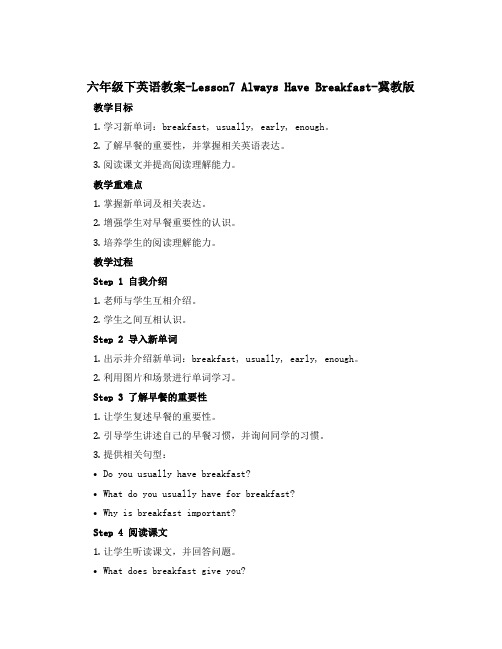
六年级下英语教案-Lesson7 Always Have Breakfast-冀教版教学目标1.学习新单词:breakfast, usually, early, enough。
2.了解早餐的重要性,并掌握相关英语表达。
3.阅读课文并提高阅读理解能力。
教学重难点1.掌握新单词及相关表达。
2.增强学生对早餐重要性的认识。
3.培养学生的阅读理解能力。
教学过程Step 1 自我介绍1.老师与学生互相介绍。
2.学生之间互相认识。
Step 2 导入新单词1.出示并介绍新单词:breakfast, usually, early, enough。
2.利用图片和场景进行单词学习。
Step 3 了解早餐的重要性1.让学生复述早餐的重要性。
2.引导学生讲述自己的早餐习惯,并询问同学的习惯。
3.提供相关句型:•Do you usually have breakfast?•What do you usually have for breakfast?•Why is breakfast important?Step 4 阅读课文1.让学生听读课文,并回答问题。
•What does breakfast give you?•What happens if you don’t have breakfast?•What do you need for a healthy breakfast?2.分组进行朗读练习。
Step 5 表达自己的看法1.让学生表态,说出自己对于早餐的认识和看法。
•I think breakfast is important because…•In my opinion, having breakfast is…2.利用课本中的问题,带领学生讨论早餐的好处。
•What are the benefits of having breakfast?•What happens if you skip breakfast?Step 6 语法训练1.引导学生将下列句子改写一下。
冀教版英语六年级下册 Lesson 7 Always Have Breakfast 教案
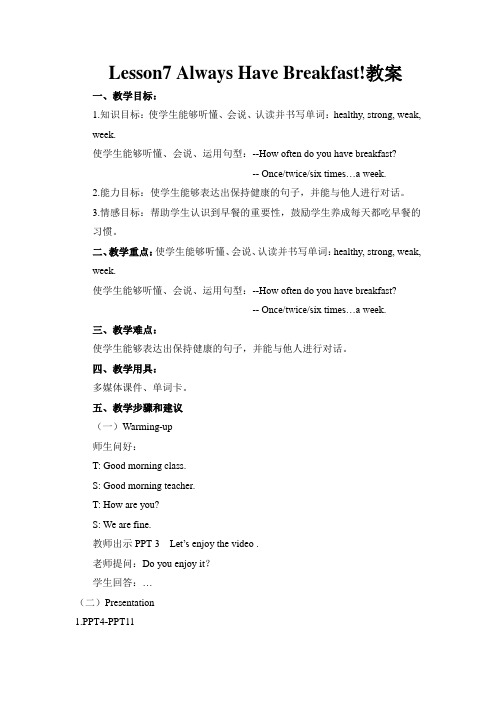
Lesson7 Always Have Breakfast!教案一、教学目标:1.知识目标:使学生能够听懂、会说、认读并书写单词:healthy, strong, weak,week.使学生能够听懂、会说、运用句型:--How often do you have breakfast?-- Once/twice/six times…a week.2.能力目标:使学生能够表达出保持健康的句子,并能与他人进行对话。
3.情感目标:帮助学生认识到早餐的重要性,鼓励学生养成每天都吃早餐的习惯。
二、教学重点:使学生能够听懂、会说、认读并书写单词:healthy, strong, weak,week.使学生能够听懂、会说、运用句型:--How often do you have breakfast?-- Once/twice/six times…a week.三、教学难点:使学生能够表达出保持健康的句子,并能与他人进行对话。
四、教学用具:多媒体课件、单词卡。
五、教学步骤和建议(一)Warming-up师生问好:T: Good morning class.S: Good morning teacher.T: How are you?S: We are fine.教师出示PPT 3 Let’s enjoy the video .老师提问:Do you enjoy it?学生回答:…(二)Presentation1.PPT4-PPT11学习本课的第1部分的内容。
(1)PPT4-5展现课文内容,首先听课文录音,学习课文第一部分.(2) PPT6 Read and answer the questions.① How often did Danny eat breakfast ?② When did Kim have breakfast ?(3) PPT7讲解课文知识点,举例紧跟。
⑴句型:主语+ want/wants to be + 形容词.……想成为……样的。
冀教版小学六年级英语下册教案《Lesson 7 Are You Ready for a Quiz》
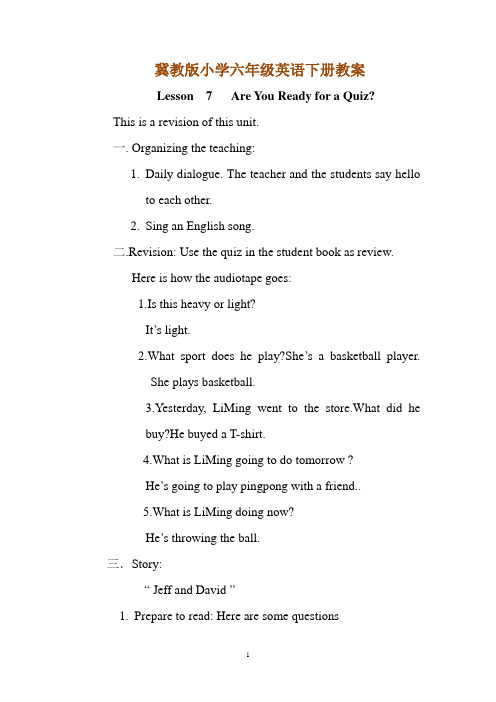
冀教版小学六年级英语下册教案Lesson 7 Are You Ready for a Quiz?This is a revision of this unit.一.Organizing the teaching:1.Daily dialogue. The teacher and the students say helloto each other.2.Sing an English song.二.Revision: Use the quiz in the student book as review.Here is how the audiotape goes:1.Is this heavy or light?It’s light.2.What sport does he play?She’s a basketball player.She plays basketball.3.Yesterday, LiMing went to the store.What did hebuy?He buyed a T-shirt.4.What is LiMing going to do tomorrow ?He’s going to play pingpong with a friend..5.What is LiMing doing now?He’s throwing the ball.三.Story:“ Jeff and David ”1.Prepare to read: Here are some questionsDoes anyone know any characters in this story?(Davidand Debbie)Does anyone remember what the Diffos like to do?What does David do differently in this story.Is his friend happy or sad?2.Read and listen to the story.3.Discuss: Here are some questions to reinforce the mainidea of the story.a.What made Jeff mad?b.What did Jeff do?c.Do you like this story?Why or why not?四.Student s’Acitvities:1.Talk freely about daily dialogue.2.Sing an English song.3.Listen and have the quiz.4.Discuss the questions to prepare the story with somevolunteers.5.Listen to the story and try to grasp the main idea ofthe story.6.Discuss the questions to check the understanding witha pair work.Teaching summing-up:。
六年级下册英语教案-Unit2Lesson7AlwaysHaveBreakfast!-冀教版
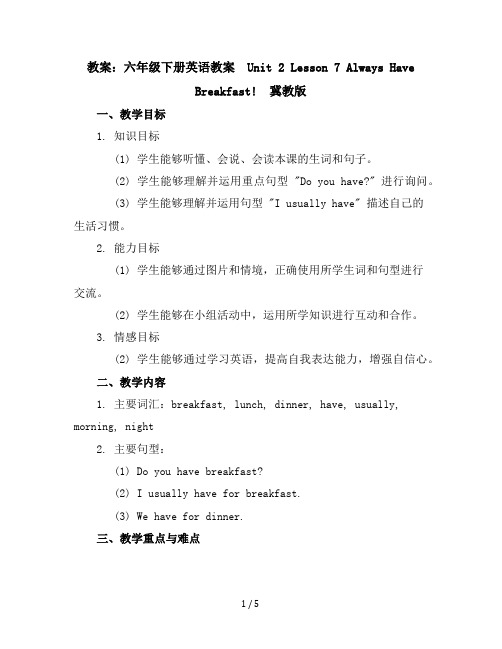
教案:六年级下册英语教案 Unit 2 Lesson 7 Always HaveBreakfast! 冀教版一、教学目标1. 知识目标(1) 学生能够听懂、会说、会读本课的生词和句子。
(2) 学生能够理解并运用重点句型 "Do you have?" 进行询问。
(3) 学生能够理解并运用句型 "I usually have" 描述自己的生活习惯。
2. 能力目标(1) 学生能够通过图片和情境,正确使用所学生词和句型进行交流。
(2) 学生能够在小组活动中,运用所学知识进行互动和合作。
3. 情感目标(2) 学生能够通过学习英语,提高自我表达能力,增强自信心。
二、教学内容1. 主要词汇:breakfast, lunch, dinner, have, usually, morning, night2. 主要句型:(1) Do you have breakfast?(2) I usually have for breakfast.(3) We have for dinner.三、教学重点与难点1. 重点:学生能够听懂、会说、会读本课的生词和句子,能够运用重点句型进行交流。
2. 难点:学生能够正确使用句型 "I usually have" 描述自己的生活习惯。
四、教具与学具准备1. 教具:PPT、图片、食物模型、录音机、磁带2. 学具:课本、练习本、铅笔、橡皮五、教学过程1. 热身活动(5分钟)(1) 教师与学生进行简单的英语对话,激发学生的学习兴趣。
(2) 学生进行小组活动,用英语介绍自己的家庭成员和他们的饮食习惯。
2. 引入新课(10分钟)(1) 教师播放录音,学生听录音并跟读句子。
(2) 教师通过PPT展示食物图片,引导学生说出对应的英文单词。
3. 新课教学(15分钟)(1) 教师通过PPT展示句型 "Do you have breakfast?",引导学生进行问答练习。
冀教版(三起)六年级下册英语教案 Lesson 7 Always Have Breakfast!
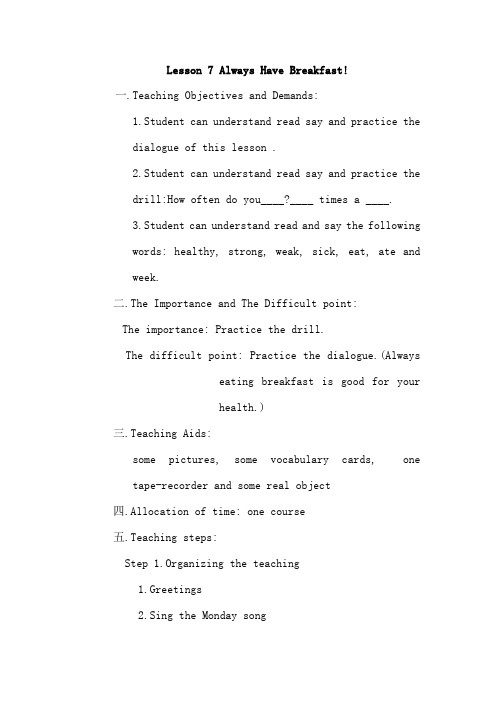
Lesson 7 Always Have Breakfast!一.Teaching Objectives and Demands:1.Student can understand read say and practice thedialogue of this lesson .2.Student can understand read say and practice thedrill:How often do you____?____ times a ____.3.Student can understand read and say the followingwords: healthy, strong, weak, sick, eat, ate and week.二.The Importance and The Difficult point:The importance: Practice the drill.The difficult point: Practice the dialogue.(Alwayseating breakfast is good for yourhealth.)三.Teaching Aids:some pictures, some vocabulary cards, one tape-recorder and some real object四.Allocation of time: one course五.Teaching steps:Step anizing the teaching1.Greetings2.Sing the Monday songStep 2. Revision1.Review adverbs of frequency and days of the week.Step 3.Key concepts:healthy, strong, weak, sick and week1.Introduce:e puppets to role-play “healthy, strong andweak”.Use actions and facial expressions:P1: (sad, coughing) I feel sick. Sick, say itplease.S:Sick.P2:(happy,energetic)I don’t feel sick.I feelhealthy.Say it, please.S:Healthy.P1:I am weak.(Try to lift a book, but can’t)Thisbook is too heavy. I am weak.Weak.S: Weak.P2:Not me!I am strong(to P1)May I help you?(Liftit)The book is heavy.But I am strong.b. Demonsrate “week” and the question and answer“How often do you ____ _____?____times a ____.”Draw boxes for each day of the week in a row on theBB.Write the days in the boxes in order, startingwith Sunday.Explain that this is a “week”.Say a sentence such as “I sometimes wash the dishes”.Then ask and answer the question:How often do I wash the dishes?Twice a week.Repeat with volunteers.2.Student book :a.Note the structure “once a week”.Instead ofsaying “one time a week”. We always say “Oncea week”.b.Note that the Student book reviews breakfastfood.c.Play the audiotape as the Ss follow along theirbooks.3.Practice: Divide the class into pairs.Ask the class to make up appropriate sentences about how often and what they eat for breakfast.六.Students’ activity:1.Sing the English song “The Monday song”.2.Make a chart to review adverbs of frequency.3.Try to review the days of the week with aquestion-and –answer drill.4.Discuss the story in the student book.5.Imitation of the dialogue.6.Pair work to practice the dialogue.七.Blackboard:Lesson 7 Always Have Breakfast!healthy-----strong sick-----weakHow often do you _________?______ times a ______.Teaching summing-up:。
六年级下册英语教案-Unit2Lesson7AlwaysHaveBreakfast!-冀教版
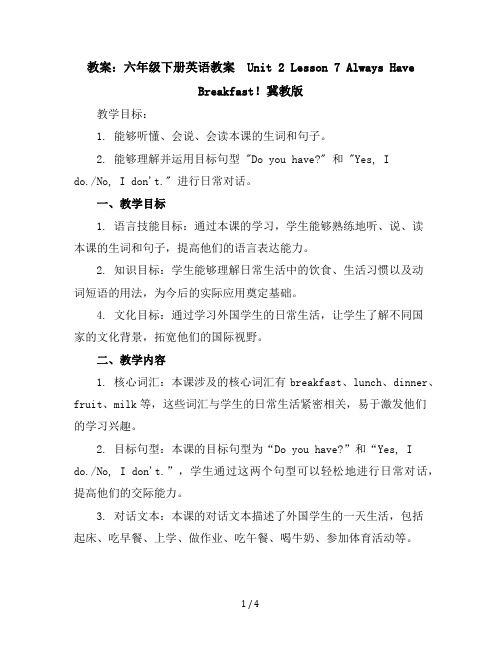
教案:六年级下册英语教案 Unit 2 Lesson 7 Always HaveBreakfast!冀教版教学目标:1. 能够听懂、会说、会读本课的生词和句子。
2. 能够理解并运用目标句型 "Do you have?" 和 "Yes, Ido./No, I don't." 进行日常对话。
一、教学目标1. 语言技能目标:通过本课的学习,学生能够熟练地听、说、读本课的生词和句子,提高他们的语言表达能力。
2. 知识目标:学生能够理解日常生活中的饮食、生活习惯以及动词短语的用法,为今后的实际应用奠定基础。
4. 文化目标:通过学习外国学生的日常生活,让学生了解不同国家的文化背景,拓宽他们的国际视野。
二、教学内容1. 核心词汇:本课涉及的核心词汇有breakfast、lunch、dinner、fruit、milk等,这些词汇与学生的日常生活紧密相关,易于激发他们的学习兴趣。
2. 目标句型:本课的目标句型为“Do you have?”和“Yes, I do./No, I don't.”,学生通过这两个句型可以轻松地进行日常对话,提高他们的交际能力。
3. 对话文本:本课的对话文本描述了外国学生的一天生活,包括起床、吃早餐、上学、做作业、吃午餐、喝牛奶、参加体育活动等。
通过学习这段对话,学生可以了解外国学生的日常生活,增强他们的跨文化交际能力。
4. 动词短语:本课涉及的动词短语有have breakfast、have lunch、have dinner、eat fruit、drink milk等,这些短语描述了学生的日常活动,有助于学生更好地掌握英语表达。
5. 语法点:本课的语法点为一般现在时。
通过本课的学习,学生需要掌握一般现在时的用法,并能运用到实际情景中。
本课的教学目标和教学内容紧密相连,旨在提高学生的语言技能、知识水平、情感态度以及文化意识。
在实际教学中,教师应注重引导学生积极参与课堂活动,让他们在实践中掌握所学知识,为今后的学习和生活打下坚实基础。
冀教版六年级下册英语第7课说课稿

冀教版六年级下册英语第7课说课稿全文共6篇示例,供读者参考篇1Unit 7: Our EnvironmentHey there, fellow classmates! Today, we're going to talk about something super important – our environment! We all know how much we love playing outside, breathing in the fresh air, and enjoying nature's beauty. But did you know that we have a big role to play in protecting our environment? That's right, it's not just up to the grown-ups; we kids can make a difference too!In this unit, we'll learn all about the different ways we can help take care of our planet. We'll start by learning some cool new words related to the environment, like "recycling," "pollution," and "conservation." These might sound like big, fancy words, but they're actually pretty easy to understand once you get the hang of them.One of the first things we'll learn about is recycling. You know how we throw away a lot of stuff, like plastic bottles, paper, and cans? Well, instead of just tossing them in the trash, we can recycle them! That means they get turned into new thingsinstead of ending up in a landfill or polluting our oceans. Isn't that neat?Speaking of pollution, we'll also learn about the different types of pollution and how they can harm our environment. There's air pollution, which makes it harder for us to breathe clean air, and water pollution, which can make plants and animals sick. But don't worry, we'll also learn about ways we can help reduce pollution, like using less plastic and turning off lights when we're not using them.Another big topic we'll cover is conservation. This is all about protecting our natural resources, like forests, lakes, and wildlife. We'll learn about the importance of these resources and how we can help conserve them for future generations. Maybe we can even plan a class trip to a nature reserve or a national park to see conservation in action!But it's not all just learning and talking; we'll also get to do some fun activities! We might make our own recycled art projects or set up a classroom recycling station. We could even have a "green day" where we all come to school wearing green and do some eco-friendly activities.And you know what's really cool? We'll learn about some amazing kids from around the world who are already making adifference in protecting the environment. They're proof that even though we're young, we can still make a big impact!So, get ready to become an eco-warrior, my friends! By the end of this unit, you'll know all sorts of ways to help take care of our planet. And who knows, maybe you'll even inspire your family and friends to start being more eco-friendly too. It's up to us to make sure our environment stays healthy and beautiful for years to come. Let's do this!篇2Hi there! Today, we're going to talk about Unit 7 in our English textbook. This unit is all about food and drinks, which is super exciting because who doesn't love food? Let me walk you through what we learned and did in class.First up, our teacher introduced us to some new vocabulary words related to food and drinks. We learned words like "recipe," "ingredient," "flavor," "delicious," and "nutritious." It was fun to practice saying these new words and learning their meanings.Next, we read a dialogue between two friends, Amy and Tom, who were talking about their favorite foods. Amy loved pizza, and Tom preferred hamburgers. We practiced reading the dialogue aloud in pairs, taking turns playing the roles of Amy andTom. It was a great way to work on our pronunciation and intonation.After that, our teacher played a video about different cuisines from around the world. We learned about Italian pasta dishes, Indian curries, Japanese sushi, and Mexican tacos. It was fascinating to see how diverse and colorful food can be in different cultures. We even got to try some international snacks that our teacher brought to class!Then, we learned about the food pyramid and the importance of having a balanced diet. Our teacher explained the different food groups and how much we should eat from each group every day. We also learned about the nutrients found in different foods and how they benefit our bodies.One of my favorite activities was when we had to create our own healthy recipe. We worked in small groups, and each group had to come up with a delicious yet nutritious dish. We had to list the ingredients, write down the steps, and even draw a picture of our dish. It was so much fun to be creative and work together as a team.After that, we learned how to order food and drinks at a restaurant. We practiced conversational phrases like "May I takeyour order?" and "What would you like to drink?" We evenrole-played being waiters and customers, which was hilarious!Towards the end of the unit, we had a potluck party in class. Each student brought a dish or snack from their culture or family tradition. We got to try all sorts of delicious foods and learn about different cultural cuisines. It was an amazing way to celebrate the diversity in our classroom and appreciate different culinary traditions.Finally, we had a review session where we played games and did activities to reinforce what we had learned throughout the unit. We played a food vocabulary game, completed a crossword puzzle, and even had a quiz to test our knowledge.Overall, Unit 7 was a lot of fun and very engaging. We learned so much about food, nutrition, and different cultures through various activities and tasks. It was a great way to improve our English skills while learning about something that is so essential and enjoyable in our daily lives.I can't wait to see what exciting topics and adventures await us in the next unit!篇3Unit 7: My HobbiesHey there! Today I'm going to tell you all about Unit 7 in our English textbook. It's called "My Hobbies" and it's super fun! We learned about different kinds of hobbies and how to talk about the things we like to do for fun.The unit starts with a reading passage called "Lily's Hobby". It's about a girl named Lily who loves collecting stamps. The passage talks about how she got interested in stamp collecting, where she gets her stamps from, and why she enjoys it so much. I thought it was really interesting to learn about her hobby!After the reading, we practiced some new vocabulary words related to hobbies. Some of the words were "collection", "collect", "exchange", and "album". We did exercises matching the words to their definitions and using them in sentences. It was a little tricky at first, but repetition helped me remember them.Then we learned how to talk about our own hobbies using "I like..." and "I'm interested in..." structures. For example, "I like reading comics" or "I'm interested in playing badminton". We had to make sentences about our personal hobbies and share them with partners. I said my hobbies are reading, swimming, and playing video games!There was also a section on asking and answering questions about hobbies using "What's your hobby?" and "My hobby is...". We practiced conversations in pairs taking turns asking and responding. It was good speaking practice.My favorite part was the project at the end where we had to make a poster about our hobby. We could draw pictures, write descriptions, and decorate it however we wanted. I made mine about video games and put some of my favorite characters on it. It was really fun to get creative!Overall, I enjoyed this unit a lot. Learning about hobbies was interesting and it gave me a chance to talk about my own interests. The activities were engaging and helped me build vocabulary and conversational skills. I'm excited to learn about the next topic!So that's the scoop on Unit 7 from me. Let me know if you have any other questions! This unit rocked and I'm stoked for more English fun.篇4Unit 7 - At the FarmThis unit is all about farms and the animals that live there. I think it's a really fun topic because farms seem like such cool places with all the different animals running around. We'll learn lots of new vocabulary words for farm animals and the things you find on a farm.First up, we started learning the names of some common farm animals like cows, sheep, chickens, pigs, horses, and ducks. It was easy for me to pick up most of those since I've seen pictures of them before. But there were a few trickier ones too like goats and roosters that I had to practice a bit more.Next, we moved on to talking about what sounds these different animals make. In English we have some funny words for the noises, like "moo" for cows, "baa" for sheep, and "oink" for pigs. My favorite is probably the "cock-a-doodleh-doo" for roosters. We did an activity where we had to match the animal to the sound it makes. I got most of them right after listening to the audio a couple times.Then we learned vocabulary for things you find on farms besides just the animals. There are barns where animals sleep, stables for horses, chicken coops for...you guessed it, chickens! Farms also have fences, fields, ponds, and tools like pitchforksand shovels. I had no idea there were so many words related to farms!We read a story about a fun day on the farm where we got to practice using all the new words and phrases we learned. It was about two kids who went to visit their aunt and uncle's farm for the weekend. They got to feed the animals, collect eggs from the chicken coop, and even ride one of the horses. Listening to and reading that story helped me see how all the new vocabulary fits together.For grammar, we focused on asking and answering questions using "What" and "Where." Like "What animal says'neigh'?" (A: A horse) or "Where do chickens lay eggs?" (A: In the chicken coop). We did lots of practice making our own questions and answering them with our new farm vocabulary.My favorite part was the hands-on activity at the end where we got to make little farm animal puppets out of paper bags! I made a sheep puppet by gluing on eyes, ears, and a fuzzy cotton ball for the body. It was fun bringing the puppets to life and making them say their animal sounds from earlier. I can't wait to take mine home and show my parents.Overall, this was a really engaging unit. I learned a ton of new words related to farms and animals. The activities were funand helped me practice the new vocabulary in different ways through reading, writing, listening, and speaking. Even though farms seem pretty simple, it turns out there's a whole world of English vocabulary to discover once you start looking around! Maybe I'll get to visit a real farm sometime and see it all for myself.篇5Unit 7: A Letter to GrannyHi everyone! Today we're going to learn about writing letters in English class. I'm really excited because I love getting mail, don't you? It's so fun to get letters and postcards from friends and family!First, our teacher showed us the letter that Li Ming wrote to his grandmother in the textbook. It goes like this:Dear Granny,How are you? I'm fine, thank you. I'm writing to tell you about my life here in Beijing.I get up at 6 o'clock every morning and go to school at 7:15.I come home at 4 o'clock in the afternoon. After school, I do myhomework and then play games with my friends in the park near our home.My favorite subjects are math and PE. Math is lots of fun because I like working with numbers. PE lets me run and play sports like basketball and football. I'm quite good at both.Mum and Dad are well. Dad is very busy at work but Mum has time to help me with my homework in the evenings. We often watch TV together after dinner. My grandad is still living with us and keeps telling me stories about when he was young.I have begun learning how to cook simple dishes like fried rice and dumplings. Cooking is interesting but I make a big mess in the kitchen! Mum has to clean up after me.My birthday is next month and I'm going to have a party. I hope you can come! I'll make sure we have all your favorite foods.Please write back soon and tell me your news.Love from,Li MingThen we learned all about the different parts of a letter like the date, greeting, body, closing, and signature. The teacherexplained that letters have a very specific format we need to follow. We practiced formatting letters correctly on the whiteboard.Next, the teacher had us work in pairs to identify different parts of Li Ming's letter, like the opening greeting "Dear Granny", the body paragraphs, and the closing "Love from, Li Ming." It was a little tricky at first but once I got the hang of it, it was easy!After that, we spent a long time going over useful phrases for different sections of a letter. For the opening greeting, we can say "Dear Grandma," "Dear Aunt Sally," etc. In the first body paragraph, it's common to ask how the person is doing, like "How have you been?" or "I hope this letter finds you well."For describing your own life, you can use phrases like "Things have been busy for me lately..." or "Let me tell you about what I've been up to..." When closing the letter, you can write "Take care," "Write back soon," or "I'm looking forward to hearing from you."The teacher had us write a bunch of exampleopening/closing lines and body paragraphs on the board. Then we played a fun game where we had to unscramble cut-up letters and put them in the right order. It was hilarious when people made really weird letter combinations!Finally, the teacher asked us to write our own short letter for homework, either to a family member or a friend. We had to use proper letter formatting and include an opening, two body paragraphs, and a closing. I decided to write to my pen pal Tommy who lives in the United States.This unit was so much fun and useful! Now I feel confident about writing polite, formatted letters in English. I can't wait to get letters back from my granny and my pen pal describing their lives. Wouldn't it be cool if we could be pen pals with students from other countries too? Writing letters is the best!篇6Title: A Clever Lesson Plan for Unit 7Hi there! My name is Lily and I'm a sixth-grader. Today, I'm going to share with you my very own lesson plan for Unit 7 of our English textbook. It's all about food and drinks, which is one of my favorite topics because I love snacking!First things first, let's talk about the warm-up activity. Our teacher always starts the class with something fun to get us in the mood for learning English. For this unit, she might ask us to name our favorite foods or drinks. I'll probably say chocolate ice cream because it's the most delicious thing ever!After the warm-up, we'll dive into the new vocabulary words. There are a lot of yummy-sounding words like "cake," "pizza," "juice," and "smoothie." I can't wait to learn how to pronounce them properly and use them in sentences. Maybe we'll even get to talk about our favorite recipes!Next up is the reading passage. It's usually a short story or an article related to the unit's theme. For Unit 7, I'm guessing it will be about different kinds of food from around the world. That sounds super interesting! I love learning about different cultures and their traditional dishes.Once we've read the passage, our teacher will ask us some comprehension questions to make sure we understood everything. I'll have to pay close attention and try my best to answer correctly. If I get stuck, I can always ask my friends for help.After that, it's time for the language focus section. This is where we learn about grammar rules, sentence structures, and other important language points. For this unit, we might learn how to use words like "some" and "any" correctly when talking about food and drinks.Then comes my favorite part: the speaking practice! We'll get to role-play different situations related to food and drinks,like ordering at a restaurant or talking about our favorite snacks.I can't wait to practice my English speaking skills with my classmates.Finally, we'll end the lesson with a fun activity or game. Maybe we'll play a game where we have to guess the food or drink based on clues. Or we could have a mini food festival in the classroom where we bring in our favorite snacks and drinks to share with everyone!Overall, I'm super excited for Unit 7. Learning about food and drinks in English is not only useful but also really enjoyable. I can't wait to see what other interesting activities and exercises our teacher has in store for us.Well, that's my lesson plan for Unit 7! I hope you found it helpful and maybe even a little bit entertaining. See you in class!。
冀教版英语六年级下册导学案24Lesson7 Always Have Breakfast!
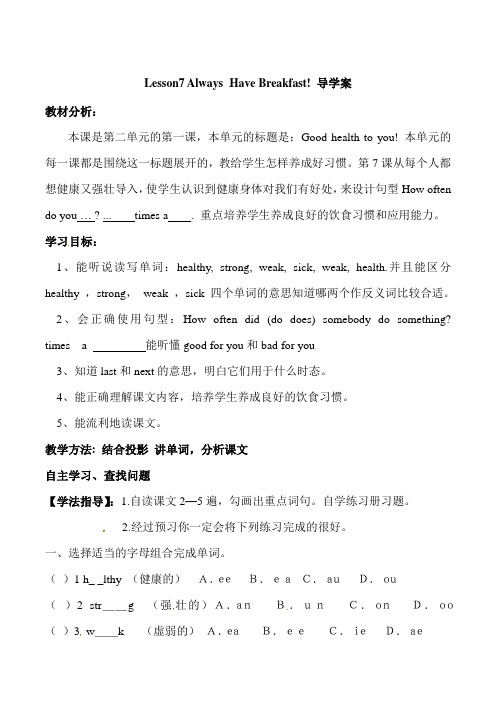
Lesson7 Always Have Breakfast! 导学案教材分析:本课是第二单元的第一课,本单元的标题是:Good health to you! 本单元的每一课都是围绕这一标题展开的,教给学生怎样养成好习惯。
第7课从每个人都想健康又强壮导入,使学生认识到健康身体对我们有好处,来设计句型How often do you … ? ... times a . 重点培养学生养成良好的饮食习惯和应用能力。
学习目标:1、能听说读写单词:healthy, strong, weak, sick, weak, health.并且能区分healthy ,strong,weak ,sick 四个单词的意思知道哪两个作反义词比较合适。
2、会正确使用句型:How often did (do does) somebody do something? times a 能听懂good for you和bad for you3、知道last和next的意思,明白它们用于什么时态。
4、能正确理解课文内容,培养学生养成良好的饮食习惯。
5、能流利地读课文。
教学方法: 结合投影讲单词,分析课文自主学习、查找问题【学法指导】:1.自读课文2—5遍,勾画出重点词句。
自学练习册习题。
2.经过预习你一定会将下列练习完成的很好。
一、选择适当的字母组合完成单词。
()1 h_ _lthy (健康的)A.eeB.eaC.auD.ou()2 str__g (强壮的)A.anB.unC.onD.oo()3 w__k (虚弱的)A.eaB.eeC.ieD.ae( ) 4. ___ ce (一次) A. e n B. o n C. a u D. u n ( ) 5. s____k (生病的) A. i c B. i a C. a u D. o u ( ) 6. ___ice (两次) A. w h B. h w C. w t D. t w二、写出下列词的正确形式。
六年级下册英语教案Lesson7AlwaysHaveBreakfast冀教版

教案:六年级下册英语教案Lesson 7 Always Have Breakfast(冀教版)教学目标:1. 知识目标:(1)能够听懂、会说、会读本课的生词和重点句子。
(2)能够运用所学知识描述日常生活中的饮食规律。
(3)能够理解并运用句型 "How about?" 提出建议。
2. 能力目标:(1)能够运用所学知识进行简单的交流和讨论。
(2)能够独立完成课堂练习和作业。
3. 情感目标:(1)培养学生的团队协作精神,提高他们的自信心和自主学习能力。
教学内容:教学重点与难点:重点:本课的生词和重点句子,以及如何运用句型 "How about" 提出建议。
难点:如何引导学生运用所学知识进行实际交流和讨论。
教具与学具准备:教具:多媒体课件、录音机、磁带。
学具:课本、练习册、铅笔、橡皮。
教学过程:Step 1:热身(5分钟)教师与学生进行简单的英语对话,检查学生对之前所学知识的掌握情况。
然后引导学生谈论日常饮食规律,引入本课主题。
Step 2:课堂讲解(15分钟)Step 3:课堂练习(10分钟)教师给出一些关于饮食的建议,让学生用句型 "How about" 提出自己的建议,并组织学生进行小组讨论。
Step 4:听力练习(10分钟)教师播放磁带,学生跟听并回答相关问题。
然后教师挑选几名学生进行听力测试,检查学生对听力材料的掌握情况。
Step 5:课堂小结(5分钟)板书设计:Lesson 7 Always Have Breakfast生词:breakfast, lunch, dinner, healthy, junk food, exercise, routine重点句子:1. Always have breakfast in the morning.2. How about having some fruit for breakfast?3. Eating junk food is bad for your health.作业设计:1. 抄写本课生词和重点句子。
冀教版六年级英语第7全册册教案.doc
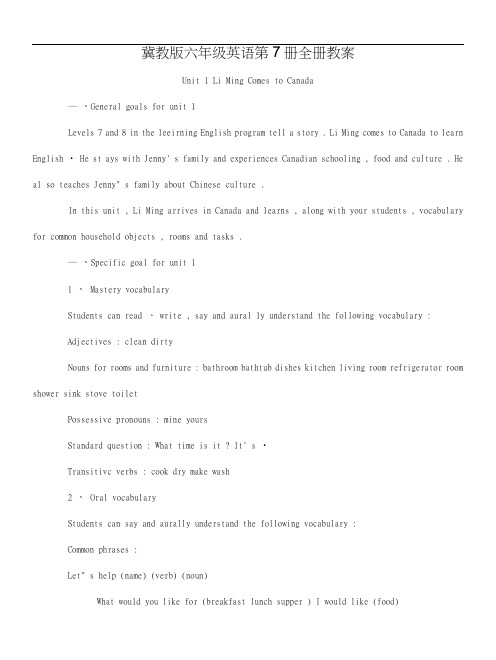
冀教版六年级英语第7册全册教案Unit 1 Li Ming Comes to Canada—、General goals for unit 1Levels 7 and 8 in the leeirning English program tell a story . Li Ming comes to Canada to learn English • He st ays with Jenny' s family and experiences Canadian schooling , food and culture . He al so teaches Jenny" s fami1y about Chinese culture .In this unit , Li Ming arrives in Canada and learns , along with your students , vocabulary for common household objects , rooms and tasks .—、Specific goal for unit 11、Mastery vocabularyStudents can read 、 write , say and aural 1y understand the following vocabulary :Adjectives : clean dirtyNouns for rooms and furniture : bathroom bathtub dishes kitchen living room refrigerator room shower sink stove toiletPossessive pronouns : mine yoursStandard question : What time is it ? It' s •Transitivc verbs : cook dry make wash2、Oral vocabularyStudents can say and aurally understand the following vocabulary :Common phrases :Let" s help (name) (verb) (noun)What wou1d you like for (breakfast lunch supper ) I wou1d like (food)3、They can understand the meaning of more extra words . 二x Importemt point : 1 and 2Difficult point : Master the pronunciation of nouns for rooms and furniturc and ask and answer the important sentences .四x Class time : Eight classes .课后小结:本课是一个复习,巩固,让学生适应长假的课时,所以在本课的讲解中,我由浅入深•先由问候语入手,逐步延伸到独hat time is it ?〃句型.学生掌握良好•有的个别的学生对"suitcases"的单复数的概念还有点模糊,有待于在教学中不断改进.本课总体来说一个复习课,没有太多的生单词,而在讲课时不能出色的完成,可以说我准备的不够,以后要引以为戒,备好每一节课,上好每一堂课.第一课时Lesson 1 At the AirportStep 1 : Class opening and Review1)Greeting2)Review①Play " The number game"' to review number , play w it h numbers up to ten t housa nd.②Review the phrases :What day is it ? What time is it ?Step 2 : Presentation and practice1、Teaching " What time is it ?"1)Use a big clock to teach " What time is it ?"2)Demonstrate : More the hands on the clock as I ask and answer the question • Then get volunteers to answer the question . Here" s a simple way to say some times in English .1:45 one forty five2:10 two ten5:37 five thirty seven8:00 eight o' clock3)Extend knowledge :2:10 two ten or ten past two4:30 four thirty or half past three9:00 nine o' clock or nine4)Practice :①Practice in pairs②Ask the volunteers to more the hands on the clock as they ask and answer the ques tion •2、Teaching " the text "1)When the students listen to the tape , think over the question :①When do Jenny , Danny , Li Ming live ?②Why is Li Ming coming to Canada ?③When does Li Ming arrive ?When will Li Ming go home ?How long will Li Ming like in Canada ?④How does he come ?@What time did Li Ming' s plane arrive ?(6)Who meets him at the airport ?⑦Did he have a good trip ?2)Read the dialogue and discuss the questions in groups •3)Ask the students to answer the questions .4)Read by themselves , then read role-play •Step 3 ConsolidationMake up a dialogue eibout meeting someone at the airport • Divide the class into small groups . Ask each group to include in their dialogue the question and answer •" What time is it ? Ts Enounce the students to be creative and to use as many Engl ish phrases as they can •Step 4 SummaryThis lesson we understand that Li Ming arrived Canada • Danny and Jenny meet Li Ming at an airport . We learned how to ask and answer the phrases " What time is it ? Tt z s “ ・Step 5 HomeworkActivity book课后小结:在讲解本课时,我采用了〃倒置〃的方法教授•先讲第二部分的几个单词,在运用挂图展示去讲解几个房间的名称,最后运用对比的方法去教授名词性物主代词.(your yours . my mine)效果不错,学生掌握的非常好•基本上都能当堂掌握.本课备课充分,条理清楚,学生掌握良好!第一课时Lesson 2 Jenny7 s HouseStep 1 Class opening and Review1)Review the phrases : What time is it ? It" s .2)Play "spell it " to review the words : house bedroom bed •Step 2 Presentation and practice1、Teach the words : room , kitchen , bathroom , living room .接上回l)Use my pastors of rooms to demonstrate each word . Ask the students to find the same point of these words .2)Practice the new words :©Read after me② Read one by one(3)Play " Simon says "④Read by themselves⑤Play a game " point " , one student say the words , the other students point quickly .2s Teach the word of bedroom : bed , clo set , door , dresser , lamp , window •1)Ask the students to say " What" s in your bedroom ? "2)As the students say the words , I write them on the blackboard .3)Practice : a : Read row by row , one by one . b : Play a game • I say a word , the studentspoint to the picture of their booksquickly •3、Teach the text1)Play the tape as the students follow in their books •2)Write the sentences and read : This is /These are •3)Explain the words : mine yoursa : Ask the students whas meaning of the two words •Explain : mine 二my . yours 二your .b : I say some sentences using mine and yours • Ten ask the students to substitute the two words using my or yourFor example : T : ( Point to a book ) This is mineS : This is my book •4)Read by themselvesStep 3 Consolidation1、Using ask and answer to practice the new words •T : Where does this go ?Ss: Living room •2、Make a dialogue to practice the words and sentences . Divide the class into small groups • Ask each group to meike up a dialogue about showing someone ciround a new house or apartment •Step 4 SummaryThis lesson we learned the names of the rooms • Please introduce them to your parentsand write them on room, s door .第二课时Lesson 3 Making Breakfast Step 1 Class opening and Review1、Play "What time is it ? " to review the way to say some2x Use a dri11 to review " batbroom , kitchen , living roomStep 2 Presentation一、Teach the new words " refrigerator , stove and sink "1x Using questions emd emswer to demonstreitc those words :T : What is cold ? (Hold up your v ocabulary card for refrigerator • cold ? S : •T : Is this cold ? (Hold up the card for stove )S :.T : Yes ! A stove is hot • say it , please •T : What has water ? Does a stove have water ?S :・T : Does a sink have water ?S :.T : Very good • A sink has water •2x Play " Simon says " to practice the new words •3x Ask the students to come to the front to read •一、Teach make and cookWe learned the words of the kitchen • Now let" s make breakfast •times •and bedroom .")Is a refrigerator1x Ask the students to make sentences using " make "2、Explain " cook "T : Now what do you want to cook ! Read a few times •(Explain " cook " always implies heating food . When you use a stove , you always “cook “)51: I want to cook •52: I want to cook .二x Study the dialogue1、Demonstrate the dialogue •T : Good morning ,.S :・T : What would you like for breakfast ?S :.T : Let" s cook eggs on the stove • Please put some dishes on the table •S :・T : Now breakfast is ready • This is yours • This is mine •2、Listen to the tape and think over these questions .①What would Jenny and Li Ming like for breakfast ?②What is Mr. Smith cooking ?③Where is the juice ?©Where do we wash dishes ?⑤What" s meaning of " mine " and " yours "3、Ask the students to read the dialogue and discuss the questions4x Ask them to answe r the questions •5、Role-play the dialogue .Step 3 Consolidcition1、Make a dialogue •Divide the class into small groups . Ask each group to make up a dialogue about a meal in a kitchon • Encourage the students to have fun and use as much vocabulary as po ssible from this unit •2x Ask them to prosent •Step 4 SummaryToday we learned a dialogue about making a meal in a kitchen • Please tel 1 your parents the name of the kitchen#s objects •Step 5 HomeworkActivity book •课后小结:本课总共三部分,一三部分复习了第一课和以前学过的一些知识,二部分又细致的讲解了〃kitchen"里的一些用具•我在讲解的时候把重点放在第二部分的教授上运用各种手段对学生进行质疑,提问,最后到能运用的不断提高.效果不错.能主次分明,重点突出.但巩固复习的内容有所忽略.值得自己总结,注意.不让类似的事情(错误)再发生!! !第四课时Lesson 4 In the bathroomStep 1 : Class opening and Review1)Greeting2)ReviewUse a picture-prompt drill to review " bathroom , kitchen , living room , bedroom . " Show pictures of objects that belong in each room and ask questions such as : What" s this ?Does this go in a ?Step 2 Presentation and practice一x Teach the words : bathtub , shower , toilet •1、Use my paster about the bathroom to introduce the new words .2s Practicc : ①Read after me②Read one by one③Pl ay "point " game一x Demonstrate " mine " and " yours " and practice1 、T : (Hold up my pencil ) This is my pencil .This is my pencil • It' s mine •Where is your pencil ?S : (Hold up his or her pencil .)T : (Point to my pencil ・)This is my pencil • That is your pencil • This is mine •That is yours .2 x Ask the students to practice in pairs •This is my • That is your •This is mine . That is yours .二x Teach the text1、Listen to the tape to No. 12"Ask the stude nts to guess the mea ni ng of " dir ty "and " wash " • Then explain :3x Ask them to read the text •4、Role-play the dialogue .四x Study the song : " In the bathroom ."1、Look at the picture and say the words •2x Play the tape and have your students sing along and do the action •3・Note that Danny says he" s " dirty " at the beginning of the song and " clean " at the end of the song . What does " clean " mean ?Step 3 SummaryToday we learned the words of the " bathroom " . Please make some cards and stick them on the objects of bathroom .Step 4 HomeworkActivity-book .课后小结:本课通过师生问答,生生互答的方法,充分练习了本课尖于"bathroom"中各部分. 运用比赛的竞技手段,学习歌曲,大幅度的提高了学生的兴趣与积极性.在教授,z shower/z时,我运用了联想音译的方法.取得了很好的效果.shower (烧鹅)二这样既生动,通俗,学生又喜闻乐见.第五课时Lesson 5 Making supperStep 1 : Class opening and Review1)Greeting2)Review①Sing " In the bathroom "②Using the cards to review rooms and objects that go in them •kitchen : stove sink refrigeratorbedroom : bed dresser closetbathroom : shower bathtub to订etliving-room : TV pictureStep 2 Presentation and practice—x Teach the new words : dishes dirty clean wash dry1x Demonstrate the new vocabulary with a basin of water , some dishes detergent , some real dishes ( dirty ) and a towel . Wash and dry the dishes (ask for a volunteer to help you •) as you say phrases • Such as :T : These are dishes • Dishes • (Read it a few times •)These dishes are dirty • (Read " dirty ")Let' s wash the dishes in the sink • ( Read " wash ")Now I7 m washing the dishes .(to a volunleer) Please help me wash the dishes . Now the dishes are clean . Look ! They" re clean •T : Now I7 m drying the dishes .(to a volunteer ) Please help me dry the dishes •二、Teach the vegetablesDo you know some vegetables ? Can you say it in English ?1x The students say then • 1 write them on the blackboard •2、Practice :1)Ask the students come to front to read •2)Play " point "二x Teach the text1x Listen to the tape and think over the follow questions :©What" s for supper ?(2)What vegetables does Mr. Smith need ?③Who is washing the dirty dishes ?④What does LT Ming do ?2x Ask the students to read the text and discuss the questions in groups •3、Ask the students to answer the questions .4x Read by thcmselvcs .Step 3 Consolidation1、Play " opposites " and include the new vocabulary : clean , dirty , wash ,dry •2 、Make a dialogueDivide the class into small groups . Ask each group to make up a dialogue about "clean , dirty , wash and dry "Step 4 SummaryStep 5 HomeworkActivity-book课后小结:本课准备的比较充分,在社区中把各个蔬菜都充分的了解了.尤其是对onion的知识.在讲课的时候比较顺手,而学生也比较积极,掌握良好.美中不足之处就是"towel"的读音,有的学生还不能掌握,需要课下加强练习.课都是一样的,重要的是教师一定要把课备好,备充分.了解学生容易混淆,不容易掌握的地方多加练习及讲解•课就一定会成功.第六课时Lesson 6 In the living roomStep 1 : Class opening and Review1、Review locations and the structure " Let" s go to the (location) to (verb) (noun) " with emo bjee t - prompt drill . When you hold up on objee the s tuden ts subs titurc a location and activity : object phrasesstove soapTV Let" s go to the to •pictureflowerbookStep 2 Presentation and practice—x Demenstrate and practice the words of living room •1 x 1 make a " living room " • Ask the students : " What1 s in the living room ?" Write them on the blackboard and read : TV , couch , book , flowers , table , picture , window , leimp •~ x Play " living picture " with No. 2 in the student book to reinforce the review vocabulary in this lesson •(Use a row of chairs for a " couch " . Use a box for a " TV " . Use another box for a " table " .) Have some other objects ready : a vase with flower , a small lamp , some books , a piece of newspaper , some plciying cards , and a piece of paper and pen • After you have the " living room " assembled , ask for volunteers to play Danny , Jenny , Li Ming , Lynn , Bob , Mr. Smith and Mrs. Smith • Read No. 2 in the studenl book aloud . As the volunteers hear their names . They take their places in the " living room " with the appropriate objects and perform the appropriate actions .二x Study the text1、Lis ten to the tape to understand the text and think over the follow questions :DWhat1 s in the living room ?2)What are they doing ?2、Discuss the questions in groups .3、Ask the students to answer the questions .4x Read by themselves •Step 3 Consolidation1x Play a variation of " Travel "Post your posters for rooms in different parts of the classroom • Ask the students to l ine up in front of each " room " . You ask and they answer questions about activities and objects that go with each room • When a student answers correctly • H e or she " Travel " to the nest room .2 s Draw your students to pretend they are Li Ming and to write a letter home about their experiences in Canada •Step 4 SummaryThis lesson we learned the words of living room and family/s activity • Pleaseyour living room to your friends .Step 5 HomeworkActivity—book •课后小结:本课生词只有一个〃COUC『・在讲解时我没有占用太多的时间,反而是在讲解小语法知识要点上加重了力度,如"everyone"和〃in the chair 〃"on a couch"等的区别•既让学生感到了乐趣,又不丸剂让学生能适时的掌握一些语法知识.学生掌握良好•尤其是对课文中每个人的活动的句式的理解和运用,表演及造句都很到位.第七课时Lesson 7 Are you ready for a quiz ?Step 1 : Class opening and Review1、Use the quiz in the student book as review listen to the tape observe your dasely .1)Is this a refrigerator or a stove ?It' s a refrigerator • It" s cold inside •2)Are these dishes clean or dirty ?T hey" re clean •3)Is this a bathtub or a shower ?It' s a shower •4)What is Mr. Smith doing ?He" s drying the dishes in the sink .5)Where" s the to订ct ?Thas easy ! It' s in the bathroom •2x Ask and answer in pairs to practice the sentences •Step 2 Read the story " Baby Becky helps her mother •"1 、Repare to read .Here are some questions you can use to prepare the students for the story :a : Who remembets Baby Becky ?b : Has anyone taken care of a little child ?c : Was it easy or hard ?d : Do little children like to share ? e : What is Baby Becky doing in this story ?2x Listen to the tape •3、Discuss •Here are some questions you can use to reinforce the main idea of the story :Did Baby Becky " help " her mother cook ?Did her mother have fun ? Why not ?How docs Baby Becky get dirty ?Where does Baby Becky have fun ?Where does her mother take Baby Becky when she is dirty ?Where does her mother go when she is tired ?Do you 1 ike this story ? Why or Why not ?Step 3 SummaryThis lesson we reviewed some sentences and understand a story . Please tell the story to your parents •Step 4 HomeworkActivity-book .课后小结:在本课的听力测试中,学生大部分能理解和回答好每句话,并能进行简单的复述, 基本上做到了〃手到,眼到,心到〃•充分达到了训练的目的。
冀教版(三起)-英语-六年级下册-Lesson 7 Always Have Breakfast优秀教案
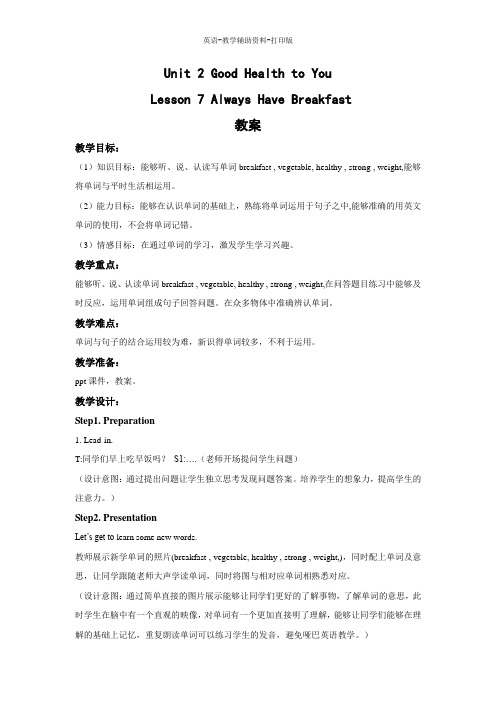
Unit 2 Good Health to YouLesson 7 Always Have Breakfast教案教学目标:(1)知识目标:能够听、说、认读写单词breakfast , vegetable, healthy , strong , weight,能够将单词与平时生活相运用。
(2)能力目标:能够在认识单词的基础上,熟练将单词运用于句子之中,能够准确的用英文单词的使用,不会将单词记错。
(3)情感目标:在通过单词的学习,激发学生学习兴趣。
教学重点:能够听、说、认读单词breakfast , vegetable, healthy , strong , weight,在问答题目练习中能够及时反应,运用单词组成句子回答问题。
在众多物体中准确辨认单词。
教学难点:单词与句子的结合运用较为难,新识得单词较多,不利于运用。
教学准备:ppt课件,教案。
教学设计:Step1. Preparation1. Lead-in.T:同学们早上吃早饭吗?S1:….(老师开场提问学生问题)(设计意图:通过提出问题让学生独立思考发现问题答案。
培养学生的想象力,提高学生的注意力。
)Step2. PresentationLet’s get to learn some new words.教师展示新学单词的照片(breakfast , vegetable, healthy , strong , weight,),同时配上单词及意思,让同学跟随老师大声学读单词,同时将图与相对应单词相熟悉对应。
(设计意图:通过简单直接的图片展示能够让同学们更好的了解事物,了解单词的意思,此时学生在脑中有一个直观的映像,对单词有一个更加直接明了理解,能够让同学们能够在理解的基础上记忆,重复朗读单词可以练习学生的发音,避免哑巴英语教学。
)Step3. Practice1.做一个关于所学单词的游戏。
名称:金手指游戏的目的:培养儿童听认词组的能力游戏的准备:在进行这个游戏前,学生一定要保证学习这个单词不低于15次的输入。
冀教版英语六下Lesson 7《Always Have breakfast》word教案
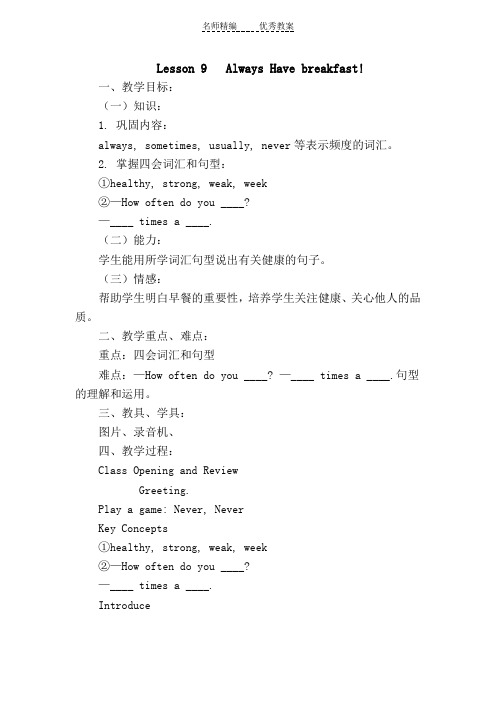
Lesson 9 Always Have breakfast!一、教学目标:(一)知识:1. 巩固内容:always, sometimes, usually, never等表示频度的词汇。
2. 掌握四会词汇和句型:①healthy, strong, weak, week②—How often do you ____?—____ times a ____.(二)能力:学生能用所学词汇句型说出有关健康的句子。
(三)情感:帮助学生明白早餐的重要性,培养学生关注健康、关心他人的品质。
二、教学重点、难点:重点:四会词汇和句型难点:—How often do you ____? —____ times a ____.句型的理解和运用。
三、教具、学具:图片、录音机、四、教学过程:Class Opening and ReviewGreeting.Play a game: Never, NeverKey Concepts①healthy, strong, weak, week②—How often do you ____?—____ times a ____.IntroduceUse puppets to role-play “healthy”, “strong”,” weak”and “sick”.P1: (Sad, coughing.) I feel sick. Sick. Say it, please, class.C: Sick.P2: (Happy, energetic.) I don’t feel sick. I feel healthy! Healthy. Say it, please.C: Healthy.P1: I am weak. Look! ( Try to carry a chair, but can’t.) This chair is too heavy. I am weak. Weak. Say it, please.C: Weak.P2: Not me. I am strong. (To Puppet 1.) May I help you with that chair? ( Carry it.) There! The chair is heavy, but I am strong. Strong. Say it, please.C: Strong.Show the pictures and introduce these words.Write “healthy”, “strong”,” weak”and “sick”on the blackboard. Ask the students try to translate them.DrillAsk the students to say who is strong/ healthy/ weak/ sick.Student book No.1IntroduceT: Everyone wants to be strong and healthy. Do you? Let’s learn what to do. First, always eat breakfast. Because it’s good for you! Do you always eat breakfast? Let’s look. Here is a chart. This is a week. There are seven days in a week. What are they? (Say Monday, Tuesday……)T: When did you eat breakfast last week?Introduce How often did you eat breakfast last week? Once/ Twice/ Three times/…… a week.Student book and audiotapePlay the audiotape and answer the questions:How often did Danny/ Kim/ Li Ming eat breakfast last week?PracticeT: We can say other things. For example: How often do you play ping-pong?Ask the students to say some sentences.Ask the students to make up appropriate sentences about how often and make up a chart.Ask the students to introduce their charts.Activity book.Class closing.。
冀教版英语六年级下册 Lesson 7 Always Have Breakfast? 教案
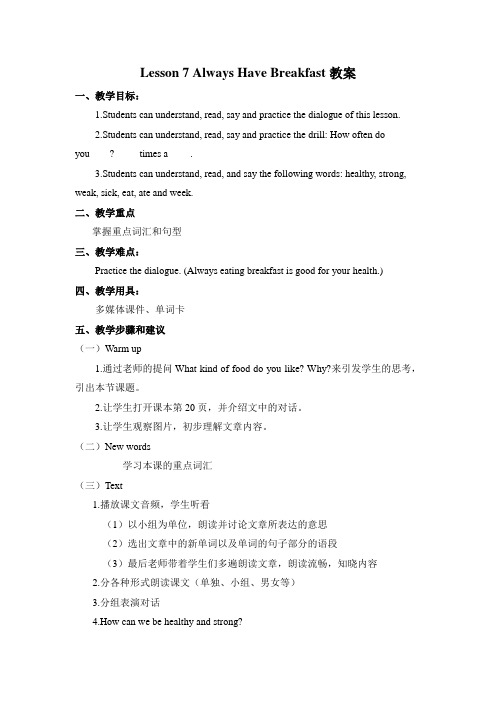
Lesson 7 Always Have Breakfast教案一、教学目标:1.Students can understand, read, say and practice the dialogue of this lesson.2.Students can understand, read, say and practice the drill: How often doyou____? ____ times a ____.3.Students can understand, read, and say the following words: healthy, strong, weak, sick, eat, ate and week.二、教学重点掌握重点词汇和句型三、教学难点:Practice the dialogue. (Always eating breakfast is good for your health.)四、教学用具:多媒体课件、单词卡五、教学步骤和建议(一)Warm up1.通过老师的提问What kind of food do you like? Why?来引发学生的思考,引出本节课题。
2.让学生打开课本第20页,并介绍文中的对话。
3.让学生观察图片,初步理解文章内容。
(二)New words学习本课的重点词汇(三)Text1.播放课文音频,学生听看(1)以小组为单位,朗读并讨论文章所表达的意思(2)选出文章中的新单词以及单词的句子部分的语段(3)最后老师带着学生们多遍朗读文章,朗读流畅,知晓内容2.分各种形式朗读课文(单独、小组、男女等)3.分组表演对话4.How can we be healthy and strong?(四)Key points1.讲解主语+want/wants to be +形容词...想要……用法并举例2.小试牛刀练习运用3.教师出示PPT18,讲解how often的用法并举例4.教师出示PPT19,总结句型:Good work.(五)Practice课本第21页,完成L et’s do it! 部分1.根据图片提示,完成句子2.选择正确答案拓展练习,运用本课所学重点知识。
Unit2Lesson7AlwaysHavebreakfast!(教案)冀教版(三起)英语六年级下册

教案:Unit 2 Lesson 7 Always Have Breakfast!一、教学目标1. 知识目标(1)能够听懂、会说、会读本课的生词和重点句子。
(2)能够运用所学知识介绍自己的早餐并描述日常饮食习惯。
2. 能力目标(1)能够运用所学知识进行简单的日常交流。
(2)能够正确使用一般现在时描述日常饮食习惯。
3. 情感目标二、教学内容1. 主题:饮食与健康。
3. 语言技能:学生需要通过听、说、读、写等方式,运用所学知识进行日常交流。
三、教学重点与难点1. 重点:掌握本课的生词和重点句子,能够运用一般现在时描述日常饮食习惯。
2. 难点:正确使用一般现在时描述日常饮食习惯,并在实际情境中进行运用。
四、教具与学具准备1. 教具:多媒体课件、录音机、磁带。
2. 学具:课本、练习册、单词卡片。
五、教学过程1. 导入:教师通过与学生谈论日常饮食,引出本课的主题。
2. 呈现:教师展示图片,引导学生说出早餐的重要性。
3. 新课内容:教师讲解一般现在时的表达方式,如“I always havefor breakfast.”,并通过示例让学生进行练习。
4. 练习:学生分组进行角色扮演,运用所学知识介绍自己的早餐并描述日常饮食习惯。
5. 巩固:教师组织游戏活动,让学生在游戏中运用所学知识。
六、板书设计板书设计如下:Unit 2 Lesson 7 Always Have Breakfast!生词:breakfast, lunch, dinner, always, sometimes, never 重点句子:I always have bread and milk for breakfast.She never has rice for dinner.一般现在时的表达方式:I always havefor breakfast.He sometimes hasfor lunch.She never hasfor dinner.七、作业设计1. 抄写本课生词和重点句子。
六年级下册英语导学案-Lesson 7 Always Eat Breakfast! 冀教版(三起)
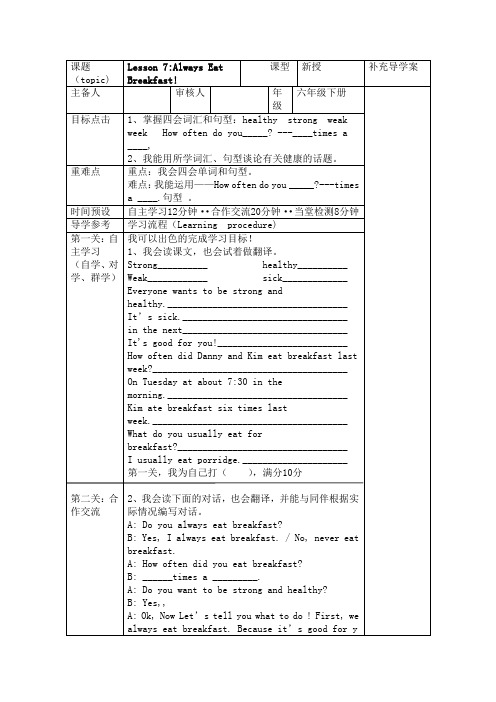
第四关:达标小检测
我可以出色的完成学习目标!
1、我会读课文,也会试着做翻译。
Strong__________ healthy__________
Weak____________ sick_____________
Everyone wants to be strong and healthy.____________________________________
c. () Li Ming eats breakfast seven times a week.
d. () Li Ming usually eats porridge for breakfast
这节课,老师为我打( )满分100分
课后反思
课题(topic)
Lesson7:Always Eat Breakfast!
课型
新授
补充导学案
主备人
审核人
年级
六年级下册
目标点击
1、掌握四会词汇和句型:healthy strong weaቤተ መጻሕፍቲ ባይዱ week How often do you_____? ---____times a ____,
2、我能用所学词汇、句型谈论有关健康的话题。
On Tuesday at about 7:30in themorning.____________________________________
Kim ate breakfast six times last week._______________________________________
1、我会编写对话
Strong and healthy
Weak and sick
冀教版(一起)六年级英语下册教案Unit 2 Lesson 7 Jenny Tells a Story教案2
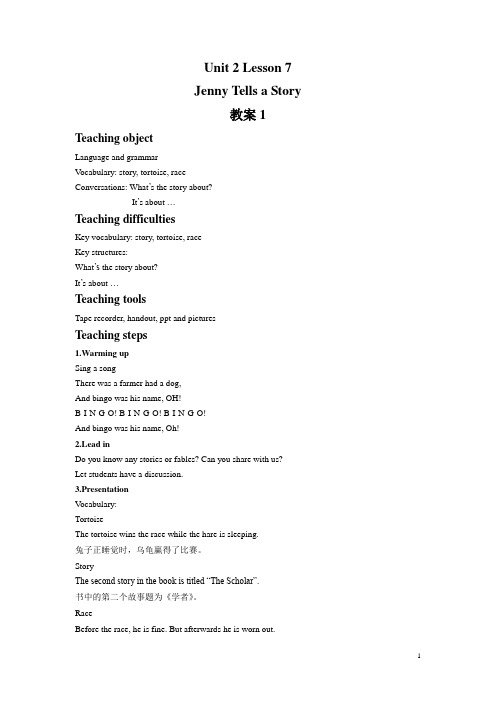
Unit 2 Lesson 7Jenny Tells a Story教案1 Teaching objectLanguage and grammarV ocabulary: story, tortoise, raceConversations: What’s the story about?It’s about …Teaching difficultiesKey vocabulary: story, tortoise, raceKey structures:What’s the story about?It’s about …Teaching toolsTape recorder, handout, ppt and picturesTeaching steps1.Warming upSing a songThere was a farmer had a dog,And bingo was his name, OH!B-I-N-G-O! B-I-N-G-O! B-I-N-G-O!And bingo was his name, Oh!2.Lead inDo you know any stories or fables? Can you share with us?Let students have a discussion.3.PresentationV ocabulary:TortoiseThe tortoise wins the race while the hare is sleeping.兔子正睡觉时,乌龟赢得了比赛。
StoryThe second story in the book is titled “The Scholar”.书中的第二个故事题为《学者》。
RaceBefore the race, he is fine. But afterwards he is worn out.赛前他状态很好,赛后就筋疲力尽了。
冀教版六年级英语下册 lesson 7 教学课件
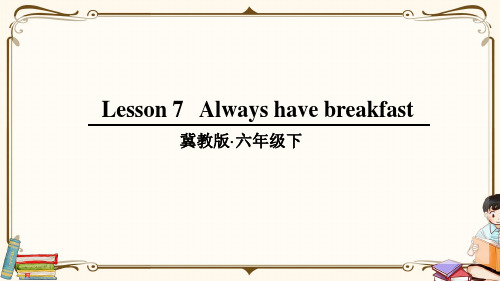
How often do you eat fruit? __________
Vegetables are good for you.
How often do you eat vegetables? ______________
Fruit is good for you.
Thank you for listening
(2)on 用于具体的某一天或者某个特定的早晨,下午 或晚上等。如 on Sunday,在星期天,on a rainy morning.在一个下雨的早晨。
例:There will be a celebration on Sunday.
(3)at 多用于较短的时间,尤其是某个具体的时刻及 固定搭配中,如 at nine in the morning.上午九点。
Kim had breakfast six times last week. Good work, Kim!
Do you always have breakfast, Li Ming?
Great!
Yes. I always have breakfast!
Language points
1. Everyone wants to be healthy and strong. 每个人都想健壮。 everyone的意思是“每个人”,做主语的时候谓语 动词要用第三人称单数形式。 同义词为everybody,反义词为nobody。 类似的词:everything,anything,anyone,nobody。
how often用来询问“频率”,表示“每间隔多久一次”。
答句中常见的频率副词有:always, usually, often, once, never, every day 等。
- 1、下载文档前请自行甄别文档内容的完整性,平台不提供额外的编辑、内容补充、找答案等附加服务。
- 2、"仅部分预览"的文档,不可在线预览部分如存在完整性等问题,可反馈申请退款(可完整预览的文档不适用该条件!)。
- 3、如文档侵犯您的权益,请联系客服反馈,我们会尽快为您处理(人工客服工作时间:9:00-18:30)。
Lesson7 Always Have Breakfast! 导学案
教材分析:本课是第二单元的第一课,本单元的标题是:Good health to you!本单元的每一课都是围绕这一标题展开的,教给学生怎样养成好习惯。
第7课从每个人都想健康又强壮导入,使学生认识到健康身体对我们有好处,来设计句型How often do you … ? ... times a 重点培养学生养成良好的饮食习惯和应用能力。
学习目标:1、能听说读写单词:healthy, strong, weak, sick, weak, health.并且能区分healthy ,strong,weak ,sick 四个单词的意思知道哪两个作反义词比较合适。
2、会正确使用句型:How often did(do does)somebody do something? times a 能听懂good for you和bad for you
3、知道last和next的意思,明白它们用于什么时态。
4、能正确理解课文内容,培养学生养成良好的饮食习惯。
5、能流利地读课文。
教学方法: 结合投影讲单词,分析课文
自主学习、查找问题
【学法指导】:1.自读课文2—5遍,勾画出重点词句。
自学练习册习题。
2.经过预习你一定会将下列练习完成的很好。
一、选择适当的字母组合完成单词。
()1 h_ _lthy(健康的)A.eeB.eaC.auD.ou
()2 str__g(强壮的)A.anB.unC.onD.oo()3 w__k(虚弱的)A.eaB.eeC.ieD.ae()4 __ce(一次)A.enB.onC.auD.un()5s__k(生病的)A.icB.iaC.auD.ou()6__ice(两次)A.whB.hwC.wtD.tw
二、写出下列词的正确形式。
1. strong(反义词)________
2.healthy(反义词)___________
3.eat(过去式)_______
4.do(过去式)________________
5. eat(单三) ___________
6. want(单三)______________三、选词填空。
( )1.Kim___ breakfast six times last week.
A.eat B.ate C.eated
( )2. -----How often did you watch TV last week?
- ----- ________ a week.
A.Two time B.Two times C.Twice
( )3.She usually eats supper _____ 6:30
A.on B.In C.at
( )4. He wants to ______ a good boy. A.is B.are C.be ( )5 -----______ do you do your homework?
A.How often B.How many C.How much
( ) 6、I eat breakfast__________ 7:30__________the morning.
A. in, at
B. at, in
C. at, on
D. on, at
( ) 7、____________breakfast is good for you.
A. Eat
B. Eats
C. Eating
D. Eatting
( )8、--_______________do you eat porridge ----Every day.
A. How much
B. How many
C. How about
D. How often ( )9、What do you eat_____________supper?
A. to
B. on
C. in
D. for
( )10、I don’t know__________________________________ .
A. how to learn English
B. how do learn English
C. how learn English
D. how English learn。
